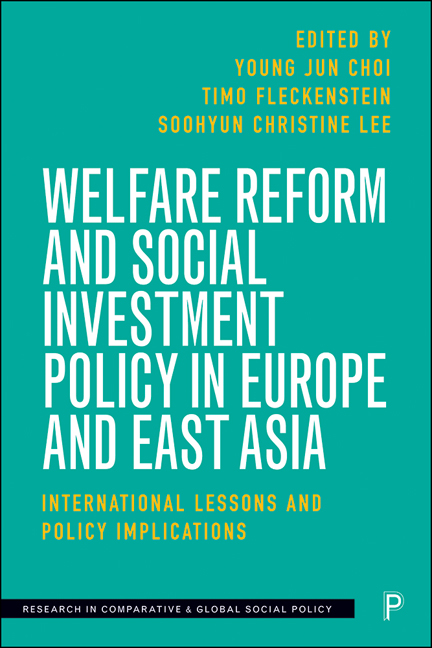Book contents
- Frontmatter
- Contents
- List of figures and tables
- Notes on contributors
- Acknowledgements
- Preface from the series editors
- 1 Introduction: social investments and welfare reform in Europe and East Asia
- 2 Work–family policy expansion and the idea of social investment: the cases of Germany, England, South Korea and Japan
- 3 Private education in South Korea: lessons for the West from past mistakes?
- 4 How do family background and shadow education affect academic performance and labour market outcomes in South Korea? Reasons for redistributive social investment
- 5 Employability, higher education and the knowledge economy
- 6 Does social investment make the labour market ‘flow’? Family policies and institutional complementarities in Italy, Spain, Japan and South Korea
- 7 The social investment approach and gender division of housework across East Asia and Europe
- 8 Employment outcomes of social investment in latecomer countries
- 9 Estimation of the human capital depreciation rate: an international comparison and policy implications in South Korea
- 10 Changing patterns of grandparenting and their implications for active ageing in England and South Korea
- 11 The governance of social investment policies in comparative perspective: long-term care in England and South Korea
- 12 Towards greater social investments and equality in Europe and East Asia: policies and politics
- Index
6 - Does social investment make the labour market ‘flow’? Family policies and institutional complementarities in Italy, Spain, Japan and South Korea
Published online by Cambridge University Press: 21 December 2021
- Frontmatter
- Contents
- List of figures and tables
- Notes on contributors
- Acknowledgements
- Preface from the series editors
- 1 Introduction: social investments and welfare reform in Europe and East Asia
- 2 Work–family policy expansion and the idea of social investment: the cases of Germany, England, South Korea and Japan
- 3 Private education in South Korea: lessons for the West from past mistakes?
- 4 How do family background and shadow education affect academic performance and labour market outcomes in South Korea? Reasons for redistributive social investment
- 5 Employability, higher education and the knowledge economy
- 6 Does social investment make the labour market ‘flow’? Family policies and institutional complementarities in Italy, Spain, Japan and South Korea
- 7 The social investment approach and gender division of housework across East Asia and Europe
- 8 Employment outcomes of social investment in latecomer countries
- 9 Estimation of the human capital depreciation rate: an international comparison and policy implications in South Korea
- 10 Changing patterns of grandparenting and their implications for active ageing in England and South Korea
- 11 The governance of social investment policies in comparative perspective: long-term care in England and South Korea
- 12 Towards greater social investments and equality in Europe and East Asia: policies and politics
- Index
Summary
Introduction
Social investment policies have gained prominence in policy-making reforms and concerned academic literature since the 1990s (Morel et al, 2012). According to Hemerijck (2015, 2017), such reforms are expected to address the problems associated with increasingly flexible career trajectories and labour markets by making transitions in and out of the labour market during one's life course smoother. Instead of simply ‘making work pay’ through labour market flexibilisation (as the neoliberal tradition had assumed), parental leave, childcare services, ‘flexicure’ employment relations, and social investment policies are expected to act as ‘social bridges’, reconnecting workers to the labour market. Such policies aim to ease life-cycle transitions and secure better employment stability at key points of risk (Hemerijck, 2015). Such risks especially affect women, who are more vulnerable to discrimination when entering the labour market, career interruptions due to motherhood and discontinuous careers. Thus, women's employment and employability are central to the social investment approach (Jenson, 2009; Morgan, 2012). Indeed, improving labour market transitions during individuals’ life course is one of the core functions of social investment (the flow function), along with the complementary efforts to boost human capital potential (the stock function) and maintain minimum safety nets for the vulnerable in ageing societies (the buffer function) (Hemerijck, 2013, 2015).
But does social investment actually make the labour market flow? In this chapter, we address this question by examining work–family reconciliation policies and women's labour market participation. While some studies suggest that there is a connection between social investment reform and the labour market (Nelson and Stephens, 2012), how exactly this happens merits deeper scrutiny at the institutional level. Since the 2000s, social investment policies have been introduced, though to varying degrees, in latecomer countries of East Asia and Southern Europe. This chapter focuses on Italy, Spain, Japan and South Korea, arguing that social investment strategies should be context-sensitive and tailored to different structural and institutional configurations if they are to be suitable and effective. These four countries provide particularly interesting cases for analysis because each has enacted important family policy reforms in the last decade, starting from a conservative, male-breadwinner oriented stance. Despite obvious geographical and cultural differences, these countries share similarities such as dualised labour markets, traditional family values and being latecomers in welfare development.
- Type
- Chapter
- Information
- Welfare Reform and Social Investment PolicyInternational Lessons and Policy Implications, pp. 129 - 166Publisher: Bristol University PressPrint publication year: 2021

